This article was included in my book Electronics for the Electrician – Prompt 2000.
When working with these devices it is important for the electrician to know something more about the “vibrations”. Of course, many electric devices such as doorbells, Iamps, and buzzers also work with light and sound, but in a more simple way than many electronic devices.
First of all, we must separate the two kinds of vibrations:
1. Sounds
When a metal bar is struck the vibrations produce disturbances in the surrounding air. These disturbances are caused by compression and decompression waves that propagate through the air in all directions, as shown in Figure 1.
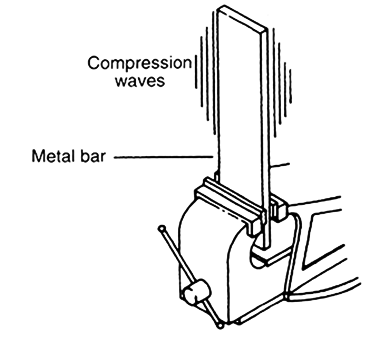
When reaching our ears these waves give us the sensation of sound.
But, to be heard as sounds the disturbances or waves must have some special characteristics.
First, the human ear can only perceive vibrations inside a limited range of frequencies or “speed” of vibrations. We can hear only the vibrations in the range of about 16 to 18,000 Hertz (vibrations per second). For example, if the bar vibrates at 30,000 Hz it produces sounds that are beyond the audible Iimit-ultrasonic vibrations.
Many animals (dogs, bats, and dolphins) can hear ultrasonic sounds.
Another important characteristic of the sounds is that the human ear can differentiate them by their frequency. Low-frequency sounds, between 16 and 500 Hz, are perceived as bass. High-frequency sounds are perceived as treble.
Our ears are sensitive enough to differentiate two sounds if their frequencies are separated of 1/16 of their value. It is because of this that we can differentiate two adjacent musical notes by the number of vibrations or frequency.
Also important is the way the metal bar is put into vibration. The natural way of vibration for a “perfect body” like a tuning fork is the one that produces a sine sound wave as shown in Figure 25.
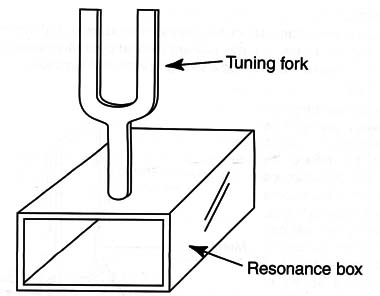
But, if the vibrations are produced by “imperfect bodies” or bodies with special formats such as musical instruments that have resonance boxes or special sizes and formats, the waveform can be different. The different waveforms give the sound a characteristic referred to as timbre or color.
Timbre allows us to differentiate between the same tone or musical note produced by a violin and a piano; they have the same frequency but different timbre.
Sounds need a material to support their propagation. What this means is that they can it propagate in a vacuum. In the air, the speed of a sound wave is about 340 m/s.
2. Radio or Electromagnetic Waves
It was in 1865 that the physicist and astronomer James Clerk Maxwell published a theory explaining the existence of electromagnetic fields or electromagnetic waves.
To explain this, begin with the idea that a standard electric charge is surrounded by an electric field and a moving electric charge is surrounded by a magnetic field as shown in Figure 3.
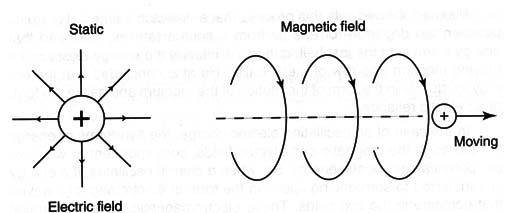
From this, a simple imaginary experiment can be done to show Maxwell's theory using a row of swinging metal balls (often sold as desktop toys) as shown in Figure 4.

If metal balls are placed end to end in a row and then one end is struck by another moving ball, as shown in (a), the motion of the striking ball is transmitted through entire row. There is little loss as the motion is passed to the ball at the other end of the row as shown in (b).
Maxwell showed with this process that a detectable time delay exists between the departure of energy from a source (striking ball) and that energy’s arrival to the last ball, during the interval the energy exists in the moving medium (the row of metal balls). He also concluded that the energy exists half in the form of the motion of the medium and half in the form of an elastic reliance.
In the case of an oscillating electric charge, the two forms of energy are stored in the magnetic and electric fields, correspondent to what we call potential and kinetic energy. So, when a charge oscillates, the energy is transferred to surrounding space in the form of electromagnetic waves that combine in the two fields.
These electromagnetic waves can travel through space with the speed of light or 300,000 km/s (as we will see, light is an electromagnetic wave).
Electromagnetic waves are present in our world in many forms. Because electromagnetic waves can be produced in any frequency from zero to infinity, they are represented by a continuum or spectrum as shown in Figure 5.
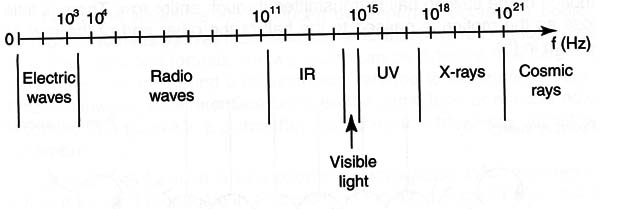
The lower part of the diagram is where radio waves used in broadcasting are found, as well as telecommunications, radar, cellular telephones, TV, remote controls, etc. A little further up is the IR or Infrared part of the spectrum. This corresponds to heat waves. Radiation in this part of the spectrum is due to thermal agitation of an object's atoms.
The next segment consists of visible light with the colors, followed by UV waves (ultraviolet radiation). At the upper end of the spectrum are X-rays, gamma rays, and cosmic rays with very high frequency and energy. For the reader who wants to work with electronics, the most important parts are those corresponding to radio waves, infrared, and visible light.
Two important quantities are associated with electromagnetic waves-wavelength and frequency. Any electromagnetic wave can be represented by sine curves corresponding to the electric and the magnetic fields as shown in Figure 6.
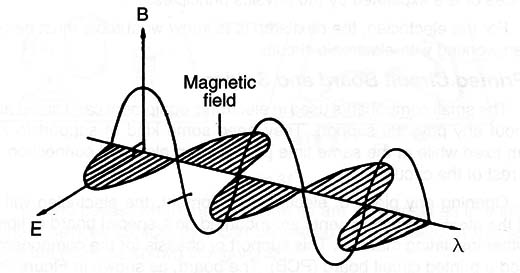
The frequency is the number of waves produced in each second and is measured in hertz (Hz). As high frequencies are common in electronic circuits, the use of the prefixes kilo (k), mega (M), giga (G), and tera (T) are common. When starting from the source, the distance traveled during one cycle can be defined as the wavelength ( Ã ).
This distance depends on the speed of the electromagnetic wave that, in a vacuum, is 300,000,000 m/s (or 300,000 km/s). 80, to calculate the wavelength of an electromagnetic wave, divide 300,000,000 by the frequency in hertz.
If, for example, the wavelength of a 100 MHz (100,000,000 Hz) signal of an FM radio broadcast station is:
λ : 300,000,000/100,000,000 : 3 meters
Knowing the wavelength of a radio wave is very important since it determines the characteristic of the antenna used to transmit or receive it.
The sizes of the elements of any radio antenna depend on the wavelength of the signal it is designed to use.
The fundamentals of electricity are the same that command electronic circuit operations. In electronic circuits, AC and DC currents pass through components and use all the common effects as you most likely studied before. Light, heat, magnetic fields, motion, images, and sounds are generated by devices that operate based on principles found in any electric devices or are explained by the physics principles.




